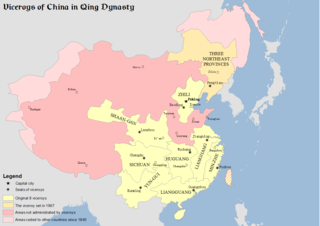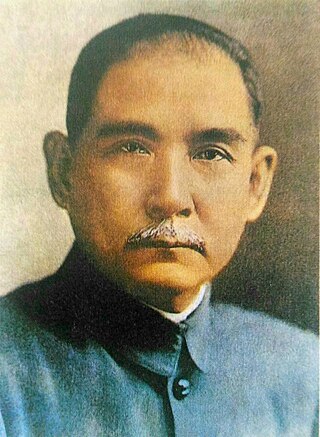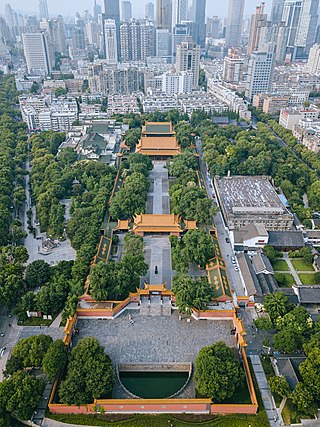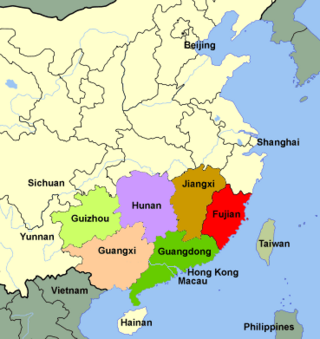There have been several battles set in and around the city of Nanjing, China. Nanjing was previously named Jianye (before 313 CE) and Jiankang (313-1368 CE). During the 19th and 20th centuries, Nanking was a popular romanization of the name in European sources. The Battle of Nanjing may refer to:
Jianye:
Jiankang:
Nanjing (Nanking):

Nanjing, alternatively romanized as Nanking, is the capital of Jiangsu province of the People's Republic of China. It is a sub-provincial city, and a megacity. The city has 11 districts, an administrative area of 6,600 km2 (2,500 sq mi), and a population of 9,423,400 as of 2021. Situated in the Yangtze River Delta region, Nanjing has a prominent place in Chinese history and culture, having served as the capital of various Chinese dynasties, kingdoms and republican governments dating from the 3rd century to 1949, and has thus long been a major center of culture, education, research, politics, economy, transport networks and tourism, being the home to one of the world's largest inland ports. The city is also one of the fifteen sub-provincial cities in the People's Republic of China's administrative structure, enjoying jurisdictional and economic autonomy only slightly less than that of a province. Nanjing has been ranked seventh in the evaluation of "Cities with Strongest Comprehensive Strength" issued by the National Statistics Bureau, and second in the evaluation of cities with most sustainable development potential in the Yangtze River Delta. It has also been awarded the title of 2008 Habitat Scroll of Honor of China, Special UN Habitat Scroll of Honor Award and National Civilized City. Nanjing is also considered a Beta city classification, together with Chongqing, Hangzhou and Tianjin by the Globalization and World Cities Research Network, and ranked as one of the world's top 100 cities in the Global Financial Centres Index.

Jiankang, or Jianye, as it was originally called, was the capital city of the Eastern Wu, the Eastern Jin dynasty and the Southern Dynasties (420–552), including the Chen dynasty. Its walls are extant as ruins in the modern municipal region of Nanjing. Jiankang was an important city of the Song dynasty. Its name was changed to Nanjing during the Ming dynasty.
Sino-Japanese War most often refers to:

The Taiping Rebellion, also known as the Taiping Civil War or the Taiping Revolution, was a civil war in China between the Manchu-led Qing dynasty and the Hakka-led Taiping Heavenly Kingdom. It lasted from 1850 until the fall of Tianjing in 1864, although the last rebel army was not wiped out until August 1871. The conflict resulted in approximately 20 to 30 million deaths, approximately one-tenth to one-twentieth of China's population at the time. The established Qing government won decisively, although at great cost to its fiscal and political structure.
This is a list of historical capitals of China.

Jiangnan is a geographic area in China referring to lands immediately to the south of the lower reaches of the Yangtze River, including the southern part of its delta. The region encompasses the city of Shanghai, the southern part of Jiangsu Province, the southeastern part of Anhui Province, the northern part of Jiangxi Province and the northern part of Zhejiang Province. The most important cities in the area include Anqing, Changzhou, Hangzhou, Nanjing, Ningbo, Shaoxing, Suzhou, Wuxi, Wenzhou, Yangzhou and Zhenjiang.

Li Xiucheng was a military rebel commander opposing the Qing dynasty during the Taiping Rebellion. He was born to a peasant family. In 1864, he was captured and interrogated following the third and final Battle of Nanjing. He was then executed by Zeng Guofan.

Zongdu were the managers supervising provincial governors in Ming and Qing China. One viceroy usually administered several provinces and was in charge of all affairs of military, food, wages, rivers, and provincial governors within their region of jurisdiction. Viceroys was appointed by and directly reported to the Emperor.

The Ming Palace, also known as the "Forbidden City of Nanjing", was the 14th-century imperial palace of the early Ming dynasty, when Nanjing was the capital of China.

The Xiang Army or Hunan Army was a standing army organized by Zeng Guofan from existing regional and village militia forces called tuanlian to contain the Taiping Rebellion in Qing China. The name is taken from the Hunan region where the Army was raised. The Army was financed through local nobles and gentry, as opposed to through the centralized Manchu-led Qing dynasty. The army was mostly disbanded by Zeng after the re-capture of the Taiping capital at Nanking.
Li Shixian was a pre-eminent military leader of the late Taiping Rebellion. He was the cousin of military leader Li Xiucheng and was known for being very tall for a native of Guangxi province, standing at 2 metres (6.6 ft) tall. During his military tenure, he was given the title of King of Shi (侍王). In the latter part of the Taiping rebellion, he led Taiping forces to many military victories. Later in his life, he invited an aging Wei Yuan to live in his home and was known to hold counsel with the famous scholar. He was eventually assassinated by a traitor in Guangdong.
Lu Jianying was the Viceroy of Liangjiang from early 1849 until early 1853. When the Taiping Rebellion army occupied Nanjing on 19 March, Lu Jianying was killed by the Taiping. Lu was the second to be killed and a few of the highest rank governors killed in action in the Qing dynasty. When Beijing knew of Lu's death and the loss of Nanjing, they chose to impeach Lu in order to place the blame on him, saying he was incapable of commanding the battle.
Jiangnan Daying or the Jiangnan Battalion; was an army group assembled by the Qing dynasty. The army group consist of mostly Green Standard Army, and their goal was to quell the Taiping Rebellion around the Jiangnan region. The army group twice encircled Nanjing, the capital of the Taiping Heavenly Kingdom, but were defeated by the Taiping forces on both occasions.

Anti-Qing sentiment refers to a sentiment principally held in China against the rule of the Manchu-led Qing dynasty (1636–1912), which was criticized by opponents as being "barbaric". The Qing was accused of destroying traditional Han culture by enforcing policies such as forcing Han to wear their hair in a queue in the Manchu style. It was blamed for suppressing Chinese science, causing China to be transformed from the world's premiere power to a poor, backwards nation. The people of the Eight Banners lived off government pensions unlike the general Han civilian population.

The Chaotian Palace, is located in Nanjing, China. It was built as an imperial palace in the Ming dynasty, and today it is known as the Nanjing Municipal Museum. Chaotian Palace area has the largest preserved traditional Chinese architectural complex in Jiangnan.

Jinghai Temple is a 15th-century temple located in Nanjing, Jiangsu, China, to the southwest of Shizi Mountain. It was built to commemorate the voyage of Zheng He in the Ming Dynasty. The terms of the Treaty of Nanking were discussed in the temple. It was destroyed and rebuilt thrice, during the Taiping Rebellion and the Second Sino-Japanese War. In 1988, it was rebuilt on its original site. In 1990, the temple became home to the Historical Exhibition Museum of the Treaty of Nanking. After two expansions in 1996 and 2005, it is now the Nanjing Jinghai Temple Memorial, with material related to both Zheng He's voyage and the Treaty of Nanking. It is a National 4A Level Scenic Spot, as well as part of the National Patriotism Education Base, and the Nanjing Relic Protection Unit.

Nanjing Fuzimiao or Fuzimiao, is a Confucius Temple and former site of imperial examination hall located in southern Nanjing City on banks of the Qinhuai River. It is now a popular tourist attraction with pedestrian shopping streets around the restored temple buildings.
The following is a timeline of the history of the city of Nanjing, Jiangsu Province, China.

The Red Turban Rebellion of 1854–1856 was a rebellion by members of the Tiandihui in the Guangdong province of South China.